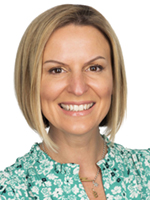In today’s rising interest rate environment, it can be tempting to lock-in yield – but making the wrong call can leave companies trapped in an unbreakable bank deposit, or in a difficult-to-unwind treasury position. BlackRock’s Beccy Milchem and Matt Clay explain why it’s time for treasury teams to adopt the mindset of a money market fund (MMF) portfolio manager.


Beccy Milchem
Head of EMEA Cash Management
BlackRock


Matt Clay
Head of International Portfolio Management for Cash Management
BlackRock

Central bank interest rates are finally on the rise following years of a low/zero interest rate environment. For corporate investors, this is welcome news – but in practice, many treasury professionals have never experienced the current interest rate environment, which can make it challenging to know how best to proceed.
“There’s a lot of excitement from clients and investors as we move off the zero-yield environment for cash investing,” comments Beccy Milchem, Head of EMEA Cash Management at BlackRock. “But the excitement can sometimes cause people to react very quickly – we’ve certainly heard from clients that are locking-in seemingly palatable yields on bank deposits.” In today’s investment environment, she warns, it is “very easy to make the wrong call.”
As such, she argues, treasurers have much to gain by understanding how money market fund portfolio managers are looking at the current markets – and that means making the right choices on duration and liquidity, while making every effort to stay close to the markets.
1. Stay short on duration
Matt Clay, Head of International Portfolio Management for Cash Management at BlackRock, says there are two main components to consider when managing portfolios. The first is the way in which the firm manages overnight liquidity that clients can access on a daily basis. The second, more strategic part of the portfolio involves investing cash down the yield curve in investments such as commercial paper and certificates of deposit.
“Whenever we move through periods of uncertainty, we increase the liquidity and decrease the duration,” he explains. “When we entered 2022, we were already in a period of relative uncertainty because of the central bank pivots, and the fact that we were now looking at rate hikes after a number of years of policy accommodation through central banks.”
In these circumstances, says Clay, “we take an opportunity to invest in shorter-term trades and increase that overnight liquidity” – an approach that builds in flexibility as interest rate hikes are delivered. As well as allowing money market funds to be as nimble as possible when opportunities arise, this approach also ensures that fund yields increase quickly after an interest rate hike.
Dry powder
For treasury teams, the prospect of adding yield by buying a fixed term instrument or adding a fixed term deposit might look appealing in today’s market. “But after a rate hike, the yield that they achieved a week or a month ago suddenly doesn’t look so good anymore,” warns Clay.
MMFs, in contrast, are positioned in short, overnight trades which provide the dry powder needed to capture any central bank or market pricing moves. As Clay notes, “That’s the benefit of investing in portfolios like these: the yield evolves over time and rises into the new interest rate environment after a central bank has delivered a rate hike.”
Another feature of the current landscape is that in the past, interest rate hikes have been immediately reflected in bank deposits, whereas MMFs – which have some elements with longer duration – can take a few days to catch up. Today, says Milchem, this lag effect has diminished, not least because the bank appetite for deposits has reduced: “One thing we’re seeing is that banks are passing on less proportionally as central bank rates rise.”
In addition, today’s treasury teams are better able to segment cash into different buckets and use the buckets of cash that aren’t needed for day-to-day use in a more strategic way, adds Milchem. “Perhaps you’ve got some capital markets activity coming up in a period of time, and you can afford to lock-in a little bit more from a duration perspective,” she observes.
With further rate hikes expected, treasury teams need to assess the implications of adding duration carefully and make sure they understand their breakeven points, particularly if their investments take them beyond a key central bank date. “It’s very important to work out which points on the curve you need to invest in to be compensated correctly for the risk that those rate hikes are delivered,” says Clay. “These things are bread-and-butter considerations for my team.”
2. Don’t forget liquidity
Liquidity is, of course, a critical consideration for treasury teams. Term bank deposits are typically unbreakable, particularly with today’s current banking regulations – meaning that penalties must be paid if cash is accessed early. As such, it’s important that companies consider their liquidity needs, and ask whether they are being fairly compensated for having a concentrated exposure to a single counterparty.
“With the market backdrop regarding the ongoing conflict in Ukraine, we are seeing credit spreads widen more than we have done over the last few years,” says Milchem. “That’s something that investors need to be mindful of.”
In addition, she notes that some clients have been going into highly rated short-term government exposures. These do offer significant liquidity – “we use them as a tool within pretty much all of our portfolios,” says Milchem – but spreads on these exposures have also been more volatile due to the recent dynamic market pricing.
Clay cites the example of a US Treasury bill, which is one of the most liquid instruments available in the money markets space. With further rate hikes expected from the Fed and the Bank of England, he says, “There is a possibility that a trade available today won’t give you the return you want if you need to sell it to raise liquidity some weeks from now. If yields move higher, the price of this asset will move lower. Whilst a US Treasury bill is almost certain to return you par at maturity, if you need to sell that asset before it matures you will likely lose money. Having a blended fund approach protects you from this single asset exposure and related mark to market risks.”
Money market funds, in contrast, are designed to catch up with the new interest rate environment. “We’ll be investing into higher yields than were available a few weeks ago,” says Clay. “You need a team of experts looking at this day in, day out to be ready to trade when opportunities arise – or not to trade if the timings aren’t right.” He adds that the scale provided by a large fund manager means that companies can maintain access to liquidity in the event of geopolitical concerns translating into more meaningful risks.
On another note, Clay says that conviction is “incredibly important” for portfolio managers. “While a safety first, liquidity first approach is more important, something that we’re always looking at is the level of conviction we have when we place trades. If our conviction rate is low, that’s another way of saying we are less certain about future outcomes – so at certain points we’d almost rather see yields fall back a little bit but have a lot more conviction before using more of our risk budget.”
3. Stay close to markets
With markets moving quickly, it is all too possible that investors who are tempted to lock-in seemingly attractive yields could rapidly find themselves trapped in an unbreakable bank deposit, or in a treasury position that would be costly to shift.
In this environment, it is more important than ever to stay close to the markets. “The market environment is tricky, and is evolving very rapidly,” says Clay. As such, companies need to work with money market specialists who can maximise liquidity and access to cash, while providing the lowest possible level of volatility – “and also enjoy the new yield environment that we are in now.”
It’s clear that treasurers are paying attention. Milchem says BlackRock is seeing greater demand for market-related content, with higher levels of attendance at the calls the firm provides focusing on cash markets. She adds: “Where viable, treasurers should be focusing on their cash investment strategies on a daily basis – and if that’s not possible, consider working with a money market fund manager who has the necessary ability and resources.”
Walking a tightrope
In closing, Clay points out that central banks are currently walking something of a tightrope. “You have the growth implications on one side, and inflation on the other, and central bank mandates are pretty clear in managing inflation risks,” he notes. “Although at the moment the direction of yields has been one-way, there will come a point where things will change – and that’s when having a dedicated resource at your disposal will be critical.”
As such, he argues, investors should consider outsourcing to dedicated cash portfolio management teams who have experience of volatile interest rate cycles. Finally, he advises that investors should sign up for market update calls such as those offered by BlackRock Cash Management, “and speak with a relationship manager about our latest portfolio positioning.”